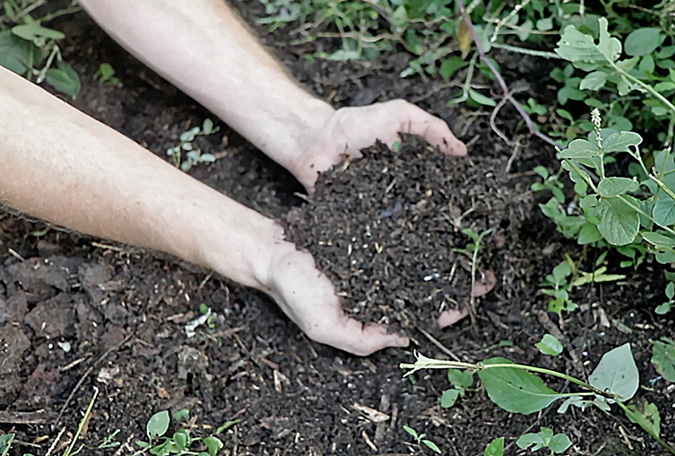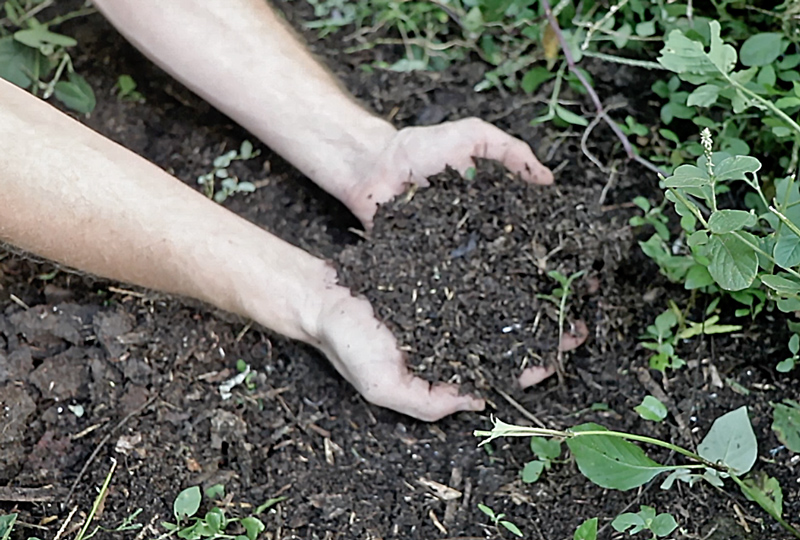Nature is a compost-generating machine. Every fall, leaves drift down from the tree canopy, blanketing the ground with organic matter. Over the following year, those leaves break down into rich humus that feeds plant roots, increases the water-holding capacity of the soil, harbors beneficial organisms, and softens hard ground.
Lasagna gardening does the same.
Last year, I recorded a fun demonstration for the 2019 Home Grown Food Summit where I built a lasagna garden from scratch. I layered a wide range of organic matter— ranging from seaweed to hay to water hyacinth plants—creating a quick, beautiful, and weed-free garden space.
That presentation is now available for free on YouTube. You can watch it here:
Now here’s the untold story behind that piece of cinematic magic: I didn’t maintain that garden after we built it!
I know—shame! Shame on you, David the Good!
At this point, if I cared to defend myself, I could share with you how I built my demonstration garden on a piece of borrowed land and how we’ve been moving to a new plot of land and how it was the dry season and how we didn’t have irrigation and how . . . .
But no one likes excuses, so I won’t defend myself.
Suffice it to say that I’ve built plenty of lasagna gardening beds and they always work wonderfully, provided they are actually maintained a little.
Even when they aren’t maintained, lasagna gardens do a great job of building the soil in a manner that mimics nature, with a few tweaks that make it even more productive than leaves falling on a forest floor. The “Back to Eden” garden works the same way. Lots and lots of organic matter is laid on top of untilled soil; then, over time, it rots down to give you some of the most amazing ground you’ve ever seen.
To show how well a lasagna garden builds soil, I did a follow-up video on that bed after abandoning it for a year:
Can you believe that compost?
Don’t buy the tall tales about how you need complicated systems or bins or tumblers and constant turning and perfect ratios of carbon and nitrogen to build compost. It’s not true. Throw organic matter on the ground and it will break down into lovely humus.
Look at this stuff!
Isn’t that amazing? I ended up getting about ten gallons of rich compost from that bed. The ground beneath the loose humus on top is also rich and could almost certainly support a wonderful vegetable garden without supplemental feeding, even with the layer on top gone.
If you have a lot of organic matter and some hard soil, water the ground, throw down some cardboard, pile up organic matter, then get planting! It’s easy to do and the results are incredible.
Further Resources
To learn more about lasagna gardening, check out the following resources:
- Lasagna Gardening by Patricia Lanza
- Gardening Without Work by Ruth Stout
- Compost Everything: The Good Guide to Extreme Composting by David The Good
- Back To Eden Film with Paul Gautschi
- David’s YouTube Channel
What Do You Think?
What are your experiences with lasagna gardening? What are your best tips for low-work gardening with great results? Let us know in the comments below!
_______________
The Grow Network is a participant in the Amazon Services LLC Associates Program, an affiliate program designed to provide a means for our team to earn fees for recommending our favorite products! We may earn a small commission, at no additional cost to you, should you purchase an item after clicking one of our links. Thanks for supporting TGN!
David The Good is a Grow Network Change Maker, a gardening expert, and the author of five books you can find on Amazon: Compost Everything: The Good Guide to Extreme Composting, Grow or Die: The Good Guide to Survival Gardening, Totally Crazy Easy Florida Gardening, Create Your Own Florida Food Forest, and Push the Zone: The Good Guide to Growing Tropical Plants Beyond the Tropics. Find fresh gardening inspiration at his website TheSurvivalGardener.com and be sure to follow his popular YouTube channel.









COMMENTS(2)
I love this style gardening since, for me, it’s the easiest to do, I just wish there was an organic way to kill the wild blackberry roots that seem to be under every inch of the clay we live on! They survive regardless of what is put on top of them and their roots apparently run many, many feet in every direction.
I must try this method. But I live in the mittel of Sweden. I have spring now , but not more than 2 weeks ago we had 30 cm snow on the ground. So it´s much colder area so i understand everything will go much slower.. But I wonder is good to use; old silage from broken packaging. As dry stuff I have dead weeds without seeds. as well as duck manure with straw and shavings from the sawmill in our area which I use as bedding inside the duck house. All material from the ducks usually becomes a nice mixture that I fertilize in my raised beds. + some compost and manure water with nettles. What else do I need to have so that this method can be translated to my conditions where I live? Thanks for the tips 🙂